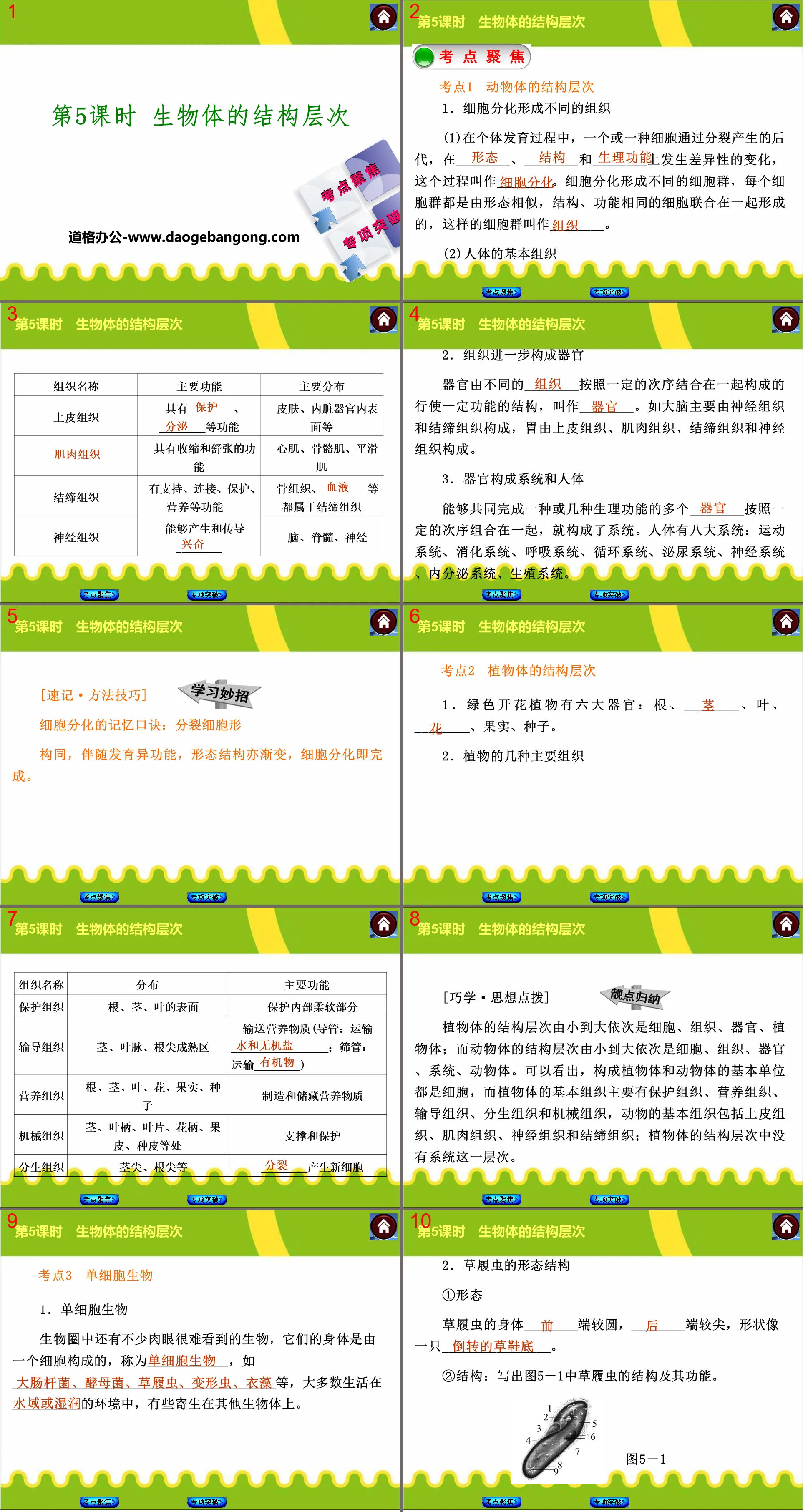Fifth Grade Science Volume 1, Textbook Edition
Science Edition for Sixth Grade Science Volume 2
Science Edition for Sixth Grade Science Volume 1
Third Grade Science Volume 2, Textbook Edition
Third Grade Science Volume 1, Textbook Edition
Fourth Grade Science Volume 1, Textbook Edition
Fourth Grade Science Volume 2, Textbook Edition
Fourth-grade science volume 2 of the E-education edition
Qingdao Edition Fourth Grade Science Volume 2
Hunan Education Edition Fourth Grade Science Volume 1
E-education edition fifth grade science volume 1
E-education edition fifth grade science volume 2
E-education edition sixth grade science volume 1
Fifth Grade Science Volume 2, Textbook Edition
Zhejiang Education Edition Seventh Grade Science Volume 2
People's Education Press Fourth Grade Science Volume 2

| Category | Format | Size |
|---|---|---|
| Zhejiang Education Edition Seventh Grade Science Volume 1 | pptx | 6 MB |
Description
"Structural Hierarchy of Organisms" PPT courseware
Part One Content: Test Points Focus
Test point 1: Structural levels of animal objects
1. Cells differentiate to form different tissues
(1) During the process of ontogeny, the offspring produced by one or a type of cell through division undergo differential changes in ________, ________ and ________. This process is called ________. Cells differentiate to form different cell groups. Each cell group is formed by cells with similar shapes, structures, and functions united together. Such cell groups are called ________.
(2) Basic tissues of the human body
2. Tissues further form organs
The structure of an organ that performs certain functions by combining different _________ in a certain order is called ________. For example, the brain is mainly composed of nervous tissue and connective tissue, and the stomach is composed of epithelial tissue, muscle tissue, connective tissue and nervous tissue.
3. Organ systems and the human body
Multiple _________ that can jointly complete one or several physiological functions are combined in a certain order to form a system. The human body has eight major systems: motor system, digestive system, respiratory system, circulatory system, urinary system, nervous system, endocrine system, and reproductive system.
Test point 2: Structural levels of plants
1. Green flowering plants have six major organs: roots, ________, leaves, ________, fruits, and seeds.
2. Several major tissues of plants
Test point 3 Single-celled organisms
1. single cell organism
There are many organisms in the biosphere that are difficult to see with the naked eye. Their bodies are composed of one cell, called ____________, such as _______________________________________________, etc. Most of them live in __________ environment, and some are parasitic on other organisms. physically.
2. Morphological structure of Paramecium
①Form
The body of a paramecium is rounded at the ________ end and pointed at the ________ end, shaped like a ______________.
② Structure: Write down the structure and function of the paramecium in Figure 5-1.
[1]________, whose function is_______________;
[2]________, whose function is_______________;
[3]________, its function is_______________;
PPT on the structural level of living organisms, part 2: special breakthroughs
Special Project 1 Core Concepts
1. Cells can divide and differentiate to generate more different types of cells for the growth, development and reproduction of organisms.
Example 1 [2014·Jinan] Diagrams are an effective way to help us understand biological concepts. A and B in Figure 5-2 respectively represent which physiological process of the cell ()
A. Cell division, cell division B. cell differentiation, cell differentiation
C. Cell division, cell differentiation D. cell differentiation, cell division
[Method Instructions] The key to solving this problem is to understand that cell division increases the number of cells, and the cell differentiation results in the formation of different tissues.
[Analysis] The growth of an organism is inseparable from the growth, division and differentiation of cells. Cells absorb nutrients from the surrounding environment and convert them into their own substances, and the volume increases. This is the growth of cells. When cells grow up, they will divide. The process: the nucleus first divides into two parts, and then the cytoplasm divides into two parts, and then forms New cell membranes, plant cells also form new cell walls. As a result, one cell divides into two cells, and cell division increases the number of cells. The fertilized egg divides to produce new cells. Later, a small part of these cells still retain the ability to divide, but most of them lose their ability to divide. During the development process, these cells each have different functions. They undergo differential changes in morphology, structure and physiological functions, forming a variety of cells. This process is called cell differentiation. The result of cell differentiation is the formation of tissues. A group of cells formed by cells with similar shapes, structures, and functions united together is called a tissue. Therefore, A in the figure represents cell division; B represents cell differentiation.
2. Some organisms are composed of single cells, and some organisms are composed of multiple cells.
Example 2 [2013·Lanzhou] Which of the following organisms is a single-celled organism ()
A. Paramecium b. rice
C. Locust D. mushroom
[ Analysis . Rice, locusts, and mushrooms are all multicellular organisms.
Keywords: Zhejiang Education Edition seventh grade science PPT courseware free download, structural hierarchy of living organisms PPT download, .PPT format;
For more information about the "Structural Hierarchy of Organisms" PPT courseware, please click the Structural Hierarchy of Organisms ppt tab.
"Structural Hierarchy of Organisms" PPT:
"Structural Hierarchy of Organisms" PPT Part One Content: Learning Objectives 1. Master the process of cell division, growth and differentiation. 2. Understand the significance of cell division, growth and differentiation. ... ... ... Structural hierarchy of living organisms PPT, part 2 content:..
File Info
Update Time: 2024-11-17
This template belongs to science courseware Zhejiang Education Edition Seventh Grade Science Volume 1 industry PPT template
"Structural Hierarchy of Organisms" PPT courseware Simple campus recruitment activity planning plan summary enterprise and institution recruitment publicity lecture PPT template is a general PPT template for business post competition provided by the manuscript PPT, simple campus recruitment activity planning plan summary enterprise and institution recruitment promotion Lecture PPT template, you can edit and modify the text and pictures in the source file by downloading the source file. If you want more exquisite business PPT templates, you can come to grid resource. Doug resource PPT, massive PPT template slide material download, we only make high-quality PPT templates!
Tips: If you open the template and feel that it is not suitable for all your needs, you can search for related content "Structural Hierarchy of Organisms" PPT courseware is enough.
How to use the Windows system template
Directly decompress the file and use it with office or wps
How to use the Mac system template
Directly decompress the file and use it Office or wps can be used
Related reading
For more detailed PPT-related tutorials and font tutorials, you can view: Click to see
How to create a high-quality technological sense PPT? 4 ways to share the bottom of the box
Notice
Do not download in WeChat, Zhihu, QQ, built-in browsers, please use mobile browsers to download! If you are a mobile phone user, please download it on your computer!
1. The manuscript PPT is only for study and reference, please delete it 24 hours after downloading.
2. If the resource involves your legitimate rights and interests, delete it immediately.
3. Contact information: service@daogebangong.com
"Structural Hierarchy of Organisms" PPT courseware, due to usage restrictions, it is only for personal study and reference use. For commercial use, please go to the relevant official website for authorization.
(Personal non-commercial use refers to the use of this font to complete the display of personal works, including but not limited to the design of personal papers, resumes, etc.)
Preview










